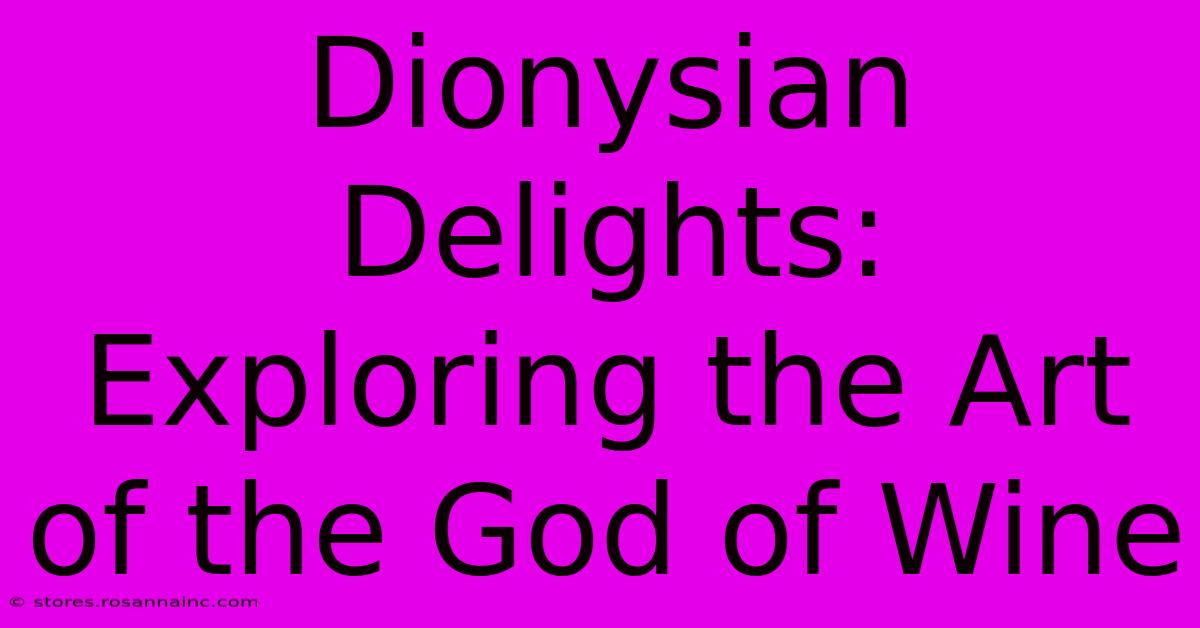Dionysian Delights: Exploring The Art Of The God Of Wine

Table of Contents
Dionysian Delights: Exploring the Art of the God of Wine
Dionysus, the Greek god of wine, theatre, fertility, ritual madness, and religious ecstasy, holds a powerful sway over our imaginations. His influence extends far beyond the simple enjoyment of a fine vintage; it permeates art, literature, and philosophy, reflecting humanity's complex relationship with pleasure, excess, and the transformative power of altered states. This exploration delves into the artistic representations of Dionysus, revealing the multifaceted nature of this enigmatic deity.
The Dual Nature of Dionysus: Ecstasy and Chaos
Dionysus is not a simple god. He embodies a duality: the ecstatic joy of wine and celebration, juxtaposed with the untamed, potentially destructive forces of nature and unrestrained passion. Artistic depictions often highlight this paradox. We see him depicted as a beautiful, youthful god, radiating vitality and mirth, but also as a wild, untamed force, surrounded by revelers engaging in ecstatic dances and potentially violent rituals. This tension is key to understanding the enduring appeal of Dionysus and his artistic representations.
Artistic Representations Throughout History:
- Ancient Greek Sculpture: Early depictions often emphasized Dionysus' youthful beauty and association with nature, showcasing him with grapevines and panthers. Later sculptures incorporated elements of his wilder, more chaotic aspects, capturing the intensity of his ecstatic rituals.
- Roman Mosaics and Frescoes: The Romans adopted Dionysus into their pantheon as Bacchus, often portraying him in lavish banquets and processions, emphasizing his association with wealth and revelry. Mosaics in particular offer vibrant depictions of these scenes, filled with detail and movement.
- Renaissance and Baroque Art: Artists revisited the theme of Dionysus, drawing inspiration from classical sources but also infusing their depictions with their own interpretations. The drama and emotion of Baroque art lent itself particularly well to depicting the god's passionate and sometimes turbulent nature.
- Modern and Contemporary Art: Dionysus continues to inspire contemporary artists, who explore his themes in diverse mediums, from painting and sculpture to performance art and film. These modern interpretations often delve into the psychological and social dimensions of his symbolism, examining themes of liberation, transgression, and the search for meaning.
The Symbolism of Wine: More Than Just a Drink
Wine, inextricably linked with Dionysus, serves as a powerful symbol in art. It represents not only intoxication and pleasure but also transformation, rebirth, and the blurring of boundaries between the mundane and the sacred. The act of drinking wine, in Dionysian rituals, becomes a ritualistic communion, connecting participants to the god and to each other. Artistic representations often use the imagery of wine to symbolize these deeper meanings.
Exploring Key Symbols:
- The Grapevine: A recurring motif representing fertility, growth, and the cyclical nature of life and death.
- The Panther: Dionysus' frequent companion, symbolizing wildness, untamed energy, and the power of instinct.
- The Thyrsus: A staff topped with a pine cone, symbolizing fertility and ecstasy. It is a key attribute in depictions of Dionysian rituals.
- Maenads: Female followers of Dionysus, representing unrestrained passion and the ecstatic energy of his rituals. Their frenzied dances often feature prominently in artistic representations.
The Enduring Legacy of Dionysus
The art inspired by Dionysus transcends time and culture. His enduring appeal lies in his embodiment of contradictory yet complementary forces: order and chaos, restraint and excess, joy and sorrow. By exploring the artistic representations of this complex god, we gain a deeper understanding not only of his mythology but also of the human condition and our enduring fascination with the power of ritual, ecstasy, and the transformative potential of art itself. The legacy of Dionysus reminds us to embrace the full spectrum of human experience, from joyous celebration to profound introspection, finding beauty and meaning in both the order and the chaos of life. His image continues to fascinate, challenge, and inspire, ensuring that the art of the god of wine will remain a vibrant and compelling subject for centuries to come.

Thank you for visiting our website wich cover about Dionysian Delights: Exploring The Art Of The God Of Wine. We hope the information provided has been useful to you. Feel free to contact us if you have any questions or need further assistance. See you next time and dont miss to bookmark.
Featured Posts
-
Unforgettable Garrett Hedlund Moments Movies And Tv That Made An Impact
Feb 11, 2025
-
New European Dates Lamar And Sza Tour
Feb 11, 2025
-
Forever Chemicals Lawsuit Can You Get Compensation
Feb 11, 2025
-
From Cheers To Millions Woody Harrelsons Net Worth Journey
Feb 11, 2025
-
Beyond The Numbers Exploring The 712 Area Code Location
Feb 11, 2025
